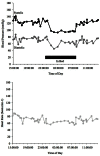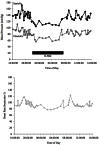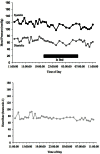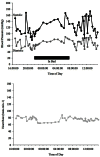Twenty-four hour non-invasive ambulatory blood pressure and heart rate monitoring in Parkinson's disease
- PMID: 23720648
- PMCID: PMC3654335
- DOI: 10.3389/fneur.2013.00049
Twenty-four hour non-invasive ambulatory blood pressure and heart rate monitoring in Parkinson's disease
Abstract
Non-motor symptoms are now commonly recognized in Parkinson's disease (PD) and can include dysautonomia. Impairment of cardiovascular autonomic function can occur at any stage of PD but is typically prevalent in advanced stages or related to (anti-Parkinsonian) drugs and can result in atypical blood pressure (BP) readings and related symptoms such as orthostatic hypotension (OH) and supine hypertension. OH is usually diagnosed with a head-up-tilt test (HUT) or an (active) standing test (also known as Schellong test) in the laboratory, but 24 h ambulatory blood pressure monitoring (ABPM) in a home setting may have several advantages, such as providing an overview of symptoms in daily life alongside pathophysiology as well as assessment of treatment interventions. This, however, is only possible if ABPM is administrated correctly and an autonomic protocol (including a diary) is followed which will be discussed in this review. A 24-h ABPM does not only allow the detection of OH, if it is present, but also the assessment of cardiovascular autonomic dysfunction during and after various daily stimuli, such as postprandial and alcohol dependent hypotension, as well as exercise and drug induced hypotension. Furthermore, information about the circadian rhythm of BP and heart rate (HR) can be obtained and establish whether or not a patient has a fall of BP at night (i.e., "dipper" vs. non-"dipper"). The information about nocturnal BP may also allow the investigation or detection of disorders such as sleep dysfunction, nocturnal movement disorders, and obstructive sleep apnea, which are common in PD. Additionally, a 24-h ABPM should be conducted to examine the effectiveness of OH therapy. This review will outline the methodology of 24 h ABPM in PD, summarize findings of such studies in PD, and briefly consider common daily stimuli that might affect 24 h ABPM.
Keywords: 24 h ambulatory blood pressure monitoring; Parkinson’s disease; autonomic protocol; circadian rhythm; non-dipping; non-invasive; orthostatic hypotension; supine hypertension.
Figures






Similar articles
-
Twenty-four-hour ambulatory blood pressure and heart rate profiles in diagnosing orthostatic hypotension in Parkinson's disease and multiple system atrophy.Eur J Neurol. 2017 Jan;24(1):90-97. doi: 10.1111/ene.13135. Epub 2016 Oct 7. Eur J Neurol. 2017. PMID: 27718292
-
Detection of orthostatic hypotension with ambulatory blood pressure monitoring in parkinson's disease.Hypertens Res. 2019 Oct;42(10):1552-1560. doi: 10.1038/s41440-019-0267-x. Epub 2019 May 22. Hypertens Res. 2019. PMID: 31118487
-
Dysautonomia: A Forgotten Condition - Part 1.Arq Bras Cardiol. 2021 Apr;116(4):814-835. doi: 10.36660/abc.20200420. Arq Bras Cardiol. 2021. PMID: 33886735 Free PMC article. English, Portuguese.
-
Cardiovascular dysautonomia and cognition in Parkinson's Disease - a possible relationship.Neurol Neurochir Pol. 2021;55(6):525-535. doi: 10.5603/PJNNS.a2021.0040. Epub 2021 May 26. Neurol Neurochir Pol. 2021. PMID: 34037978 Review.
-
Blood Pressure Patterns in Patients with Parkinson's Disease: A Systematic Review.J Pers Med. 2021 Feb 15;11(2):129. doi: 10.3390/jpm11020129. J Pers Med. 2021. PMID: 33671878 Free PMC article. Review.
Cited by
-
Non-dipping nocturnal blood pressure and psychosis parameters in Parkinson disease.Clin Auton Res. 2015 Apr;25(2):109-16. doi: 10.1007/s10286-015-0270-5. Epub 2015 Feb 18. Clin Auton Res. 2015. PMID: 25690741
-
Molecular characterization of the circadian clock in patients with Parkinson's disease-CLOCK4PD Study protocol.PLoS One. 2024 Jul 19;19(7):e0305712. doi: 10.1371/journal.pone.0305712. eCollection 2024. PLoS One. 2024. PMID: 39028707 Free PMC article.
-
Aortic stiffness and central systolic pressure are associated with ambulatory orthostatic BP fall in chronic kidney disease.J Nephrol. 2020 Apr;33(2):317-324. doi: 10.1007/s40620-019-00655-6. Epub 2019 Oct 9. J Nephrol. 2020. PMID: 31598911
-
Circadian disruption and human health: A bidirectional relationship.Eur J Neurosci. 2020 Jan;51(1):567-583. doi: 10.1111/ejn.14298. Epub 2019 Jan 3. Eur J Neurosci. 2020. PMID: 30549337 Free PMC article. Review.
-
Cardiovascular complications in patients with autonomic failure.Clin Auton Res. 2015 Jun;25(3):133-40. doi: 10.1007/s10286-015-0275-0. Epub 2015 Mar 20. Clin Auton Res. 2015. PMID: 25791260 Review.
References
-
- Alli C., Avanzini F., Bettelli G., Colombo F., Corso R., Di Tullio M., et al. (1992). Prevalence and variability of orthostatic hypotension in the elderly. Results of the ‘Italian study on blood pressure in the elderly (SPAA)’. The ‘Gruppo di Studio Sulla Pressione Arteriosa nell’Anziano’. Eur. Heart J. 13, 178–182 - PubMed
LinkOut - more resources
Full Text Sources
Other Literature Sources
Medical

